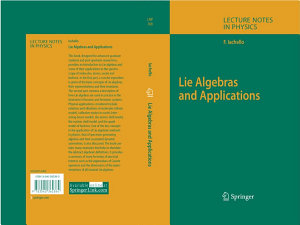Lie Algebras and Applications
ਫ਼ਰ 2007 · Lecture Notes in Physics ਕਿਤਾਬ 708 · Springer
ਈ-ਕਿਤਾਬ
196
ਪੰਨੇ
reportਰੇਟਿੰਗਾਂ ਅਤੇ ਸਮੀਖਿਆਵਾਂ ਦੀ ਪੁਸ਼ਟੀ ਨਹੀਂ ਕੀਤੀ ਗਈ ਹੈ ਹੋਰ ਜਾਣੋ
ਇਸ ਈ-ਕਿਤਾਬ ਬਾਰੇ
In the second part of the 20th century, algebraic methods have emerged as a powerful tool to study theories of physical phenomena, especially those of quantal systems. The framework of Lie algebras, initially introduced by - phus Lie in the last part of the 19th century, has been considerably expanded to include graded Lie algebras, in?nite-dimensional Lie algebras, and other algebraic constructions. Algebras that were originally introduced to describe certainpropertiesofaphysicalsystem,inparticularbehaviorunderrotations and translations, have now taken center stage in the construction of physical theories. This book contains a set of notes from lectures given at Yale Univ- sity and other universities and laboratories in the last 20 years. The notes are intended to provide an introduction to Lie algebras at the level of a one-semester graduate course in physics. Lie algebras have been particularly useful in spectroscopy, where they were introduced by Eugene Wigner and Giulio Racah. Racah’s lectures were given at Princeton University in 1951 (Group Theory and Spectroscopy) and they provided the impetus for the initial applications in atomic and nuclear physics. In the intervening years, many other applications have been made. This book contains a brief account of some of these applications to the ?elds of molecular, atomic, nuclear, and particle physics. The application of Lie algebraic methods in Physics is so wide that often students are overwhelmed by the sheer amount of material to absorb.
ਇਸ ਈ-ਕਿਤਾਬ ਨੂੰ ਰੇਟ ਕਰੋ
ਆਪਣੇ ਵਿਚਾਰ ਦੱਸੋ
ਪੜ੍ਹਨ ਸੰਬੰਧੀ ਜਾਣਕਾਰੀ
ਸਮਾਰਟਫ਼ੋਨ ਅਤੇ ਟੈਬਲੈੱਟ
Google Play Books ਐਪ ਨੂੰ Android ਅਤੇ iPad/iPhone ਲਈ ਸਥਾਪਤ ਕਰੋ। ਇਹ ਤੁਹਾਡੇ ਖਾਤੇ ਨਾਲ ਸਵੈਚਲਿਤ ਤੌਰ 'ਤੇ ਸਿੰਕ ਕਰਦੀ ਹੈ ਅਤੇ ਤੁਹਾਨੂੰ ਕਿਤੋਂ ਵੀ ਆਨਲਾਈਨ ਜਾਂ ਆਫ਼ਲਾਈਨ ਪੜ੍ਹਨ ਦਿੰਦੀ ਹੈ।
ਲੈਪਟਾਪ ਅਤੇ ਕੰਪਿਊਟਰ
ਤੁਸੀਂ ਆਪਣੇ ਕੰਪਿਊਟਰ ਦਾ ਵੈੱਬ ਬ੍ਰਾਊਜ਼ਰ ਵਰਤਦੇ ਹੋਏ Google Play 'ਤੇ ਖਰੀਦੀਆਂ ਗਈਆਂ ਆਡੀਓ-ਕਿਤਾਬਾਂ ਸੁਣ ਸਕਦੇ ਹੋ।
eReaders ਅਤੇ ਹੋਰ ਡੀਵਾਈਸਾਂ
e-ink ਡੀਵਾਈਸਾਂ 'ਤੇ ਪੜ੍ਹਨ ਲਈ ਜਿਵੇਂ Kobo eReaders, ਤੁਹਾਨੂੰ ਫ਼ਾਈਲ ਡਾਊਨਲੋਡ ਕਰਨ ਅਤੇ ਇਸਨੂੰ ਆਪਣੇ ਡੀਵਾਈਸ 'ਤੇ ਟ੍ਰਾਂਸਫਰ ਕਰਨ ਦੀ ਲੋੜ ਹੋਵੇਗੀ। ਸਮਰਥਿਤ eReaders 'ਤੇ ਫ਼ਾਈਲਾਂ ਟ੍ਰਾਂਸਫਰ ਕਰਨ ਲਈ ਵੇਰਵੇ ਸਹਿਤ ਮਦਦ ਕੇਂਦਰ ਹਿਦਾਇਤਾਂ ਦੀ ਪਾਲਣਾ ਕਰੋ।








